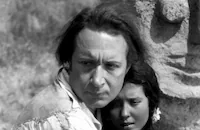Jim Bludso
Cast & Crew
Tod Browning
Wilfred Lucas
Olga Grey
George Stone
Charles Lee
Winifred Westover
Film Details
Technical Specs

Synopsis
At the end of the Civil War, engineer Jim Bludso, accompanied by his friend, Banty Tim, returns home to the town of Gilgal, and discovers that his wife Gabrielle has deserted him and their son Breeches for another man. Jim is welcomed by Kate Taggart, the village storekeeper's daughter, and their attachment deepens until Gabrielle returns after being deserted by her paramour, and Jim forgives her for their son's sake. Meanwhile, Ben Merrill, an unscrupulous contractor who has built the town levee, fears that the structure will not hold the coming flood waters. Merrill destroys the levee and attempts to place the blame on Jim and Banty Tim. In the flood, Gabrielle is killed, but before dying, she exposes Merrill as the man for whom she had deserted her home. This information reaches Jim when he and Merrill are aboard the boat The Prairie Bell . In the ensuing fight, the ship catches fire and explodes. Rescued from the debris by Banty Tim, Jim marries Kate and begins a new life.

Cast

Wilfred Lucas
Olga Grey
George Stone
Charles Lee
Winifred Westover
Sam De Grasse
James O'shea

Monte Blue

Film Details
Technical Specs

Quotes
Trivia
Notes
John Hay was the Secretary of State under William McKinley and Theodore Roosevelt. Some contemporary sources credit Browning as the sole director, while others give Browning and Lucas joint credit; one credits Browning as director and Lucas as co-director. Scenes from the film were shot in San Francisco, Rio Vista and Nigger Clough, CA.













